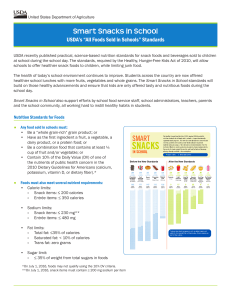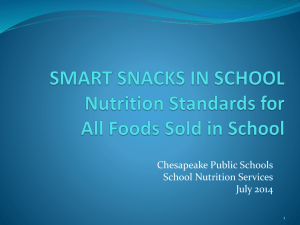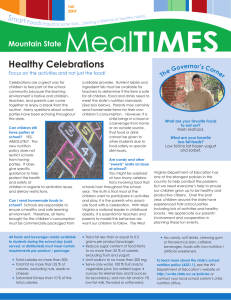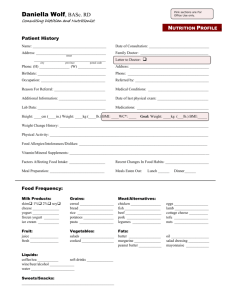Smart Snacks in School USDA’s “All Foods Sold in Schools” Standards
advertisement
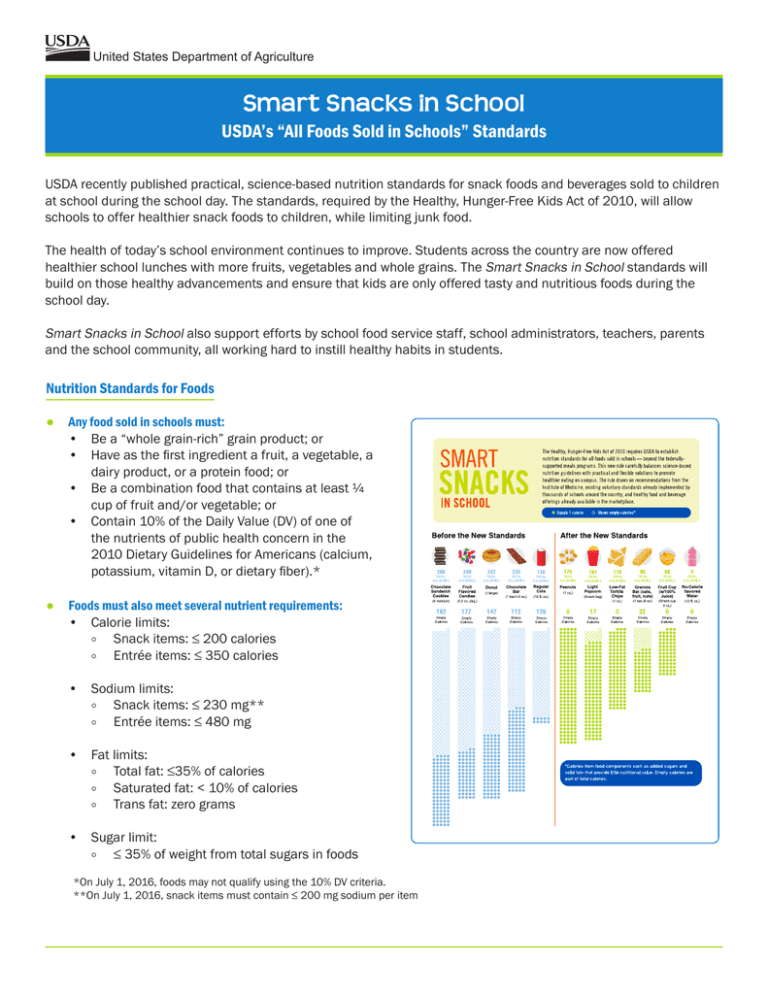
United States Department of Agriculture Smart Snacks in School USDA’s “All Foods Sold in Schools” Standards USDA recently published practical, science-based nutrition standards for snack foods and beverages sold to children at school during the school day. The standards, required by the Healthy, Hunger-Free Kids Act of 2010, will allow schools to offer healthier snack foods to children, while limiting junk food. The health of today’s school environment continues to improve. Students across the country are now offered healthier school lunches with more fruits, vegetables and whole grains. The Smart Snacks in School standards will build on those healthy advancements and ensure that kids are only offered tasty and nutritious foods during the school day. Smart Snacks in School also support efforts by school food service staff, school administrators, teachers, parents and the school community, all working hard to instill healthy habits in students. Nutrition Standards for Foods ● Any food sold in schools must: • Be a “whole grain-rich” grain product; or • Have as the first ingredient a fruit, a vegetable, a dairy product, or a protein food; or • Be a combination food that contains at least ¼ cup of fruit and/or vegetable; or • Contain 10% of the Daily Value (DV) of one of the nutrients of public health concern in the 2010 Dietary Guidelines for Americans (calcium, potassium, vitamin D, or dietary fiber).* ● Foods must also meet several nutrient requirements: • Calorie limits: ° Snack items: ≤ 200 calories ° Entrée items: ≤ 350 calories • Sodium limits: ° Snack items: ≤ 230 mg** ° Entrée items: ≤ 480 mg • Fat limits: ° Total fat: ≤35% of calories ° Saturated fat: < 10% of calories ° Trans fat: zero grams • Sugar limit: ° ≤ 35% of weight from total sugars in foods *On July 1, 2016, foods may not qualify using the 10% DV criteria. **On July 1, 2016, snack items must contain ≤ 200 mg sodium per item Smart Snacks in School: USDA’s “All Foods Sold in Schools” Standards Nutrition Standards for Beverages ● All schools may sell: • Plain water (with or without carbonation) • Unflavored low fat milk • Unflavored or flavored fat free milk and milk alternatives permitted by NSLP/SBP • 100% fruit or vegetable juice and • 100% fruit or vegetable juice diluted with water (with or without carbonation), and no added sweeteners. ● Elementary schools may sell up to 8-ounce portions, while middle schools and high schools may sell up to 12-ounce portions of milk and juice. There is no portion size limit for plain water. ● Beyond this, the standards allow additional “no calorie” and “lower calorie” beverage options for high school students. • No more than 20-ounce portions of • Calorie-free, flavored water (with or without carbonation); and • Other flavored and/or carbonated beverages that are labeled to contain < 5 calories per 8 fluid ounces or ≤ 10 calories per 20 fluid ounces. • No more than 12-ounce portions of • Beverages with ≤ 40 calories per 8 fluid ounces, or ≤ 60 calories per 12 fluid ounces. Other Requirements ●Fundraisers • The sale of food items that meet nutrition requirements at fundraisers are not limited in any way under the standards. • The standards do not apply during non-school hours, on weekends and at off-campus fundraising events. • The standards provide a special exemption for infrequent fundraisers that do not meet the nutrition standards. State agencies may determine the frequency with which fundraising activities take place that allow the sale of food and beverage items that do not meet the nutrition standards. ●Accompaniments • Accompaniments such as cream cheese, salad dressing and butter must be included in the nutrient profile as part of the food item sold. • This helps control the amount of calories, fat, sugar and sodium added to foods by accompaniments, which can be significant. Comment Online: Public Comment http://www.regulations.gov USDA is seeking comments on these standards. The formal 120-day comment period is open through October 28, 2013. We also want to continue to receive feedback during implementation of the standards, so that we are able to make any needed tweaks to the standards based on real-world experience. Feedback from students, parents, school food staff, school administrators, State agencies and other interested parties is critical to ensuring successful standards. To find the standards online, simply go to http://www.regulations.gov and search by the docket number, which is FNS-2011-0019,or ou may type in the name of the rule “Nutrition Standards for All Foods Sold in School”. USDA is an equal opportunity provider and employer. Comment by Mail: William Wagoner Section Chief, Policy and Program Development Branch Child Nutrition Division Food and Nutrition Service P.O. Box 66874 St. Louis, MO 63166
